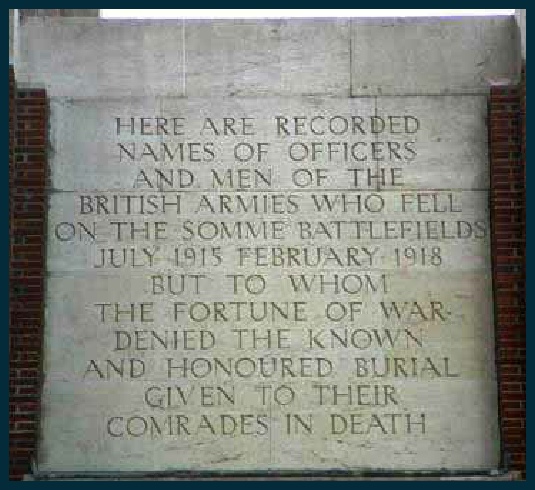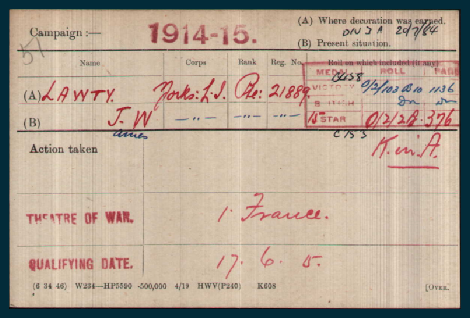Copyright © All rights reserved.



William Lawty

There seems to be a doubt as to whether Private Lawty was known as James or William. He was born in the first quarter of 1879 in Malton and baptised at St Leonard’s Church on 19th March 1879 as William James after the death of his older brother James William in infancy. He was the only surviving son of James and Ellen (nee Fowler) Lawty who married in New Malton on 25 January 1874. The Census of 1881 records the family as living in Unitarian Chapel Yard. The then Unitarian Chapel is now the Greengate Centre and the Yard is now largely built over by the Post Office. James was a journeyman tailor supporting a wife and two small children, Sarah Eliza and William James.
1881 Census – resident at Unitarian Chapel Yard, New Malton
LAWTY, James, Head, Married, M, 32, Journeyman Tailor, Langtoft Yorkshire,
LAWTY, Ellen, Wife, Married, F, 35, , Malton Yorkshire,
LAWTY, Eliza, Daughter, Single, F, 3, , Malton Yorkshire,
LAWTY, William J, Son, Single, M, 2, , Malton Yorkshire,
1891 sees their address as Masterman’s Yard, which appears to be the same place, and there are now two younger girls in the family as well, though James has now shed the descriptor Journeyman and is working as a tailor.
1891 Census – resident at Masterman’s Yard, Wheelgate, Malton
LAWTY, James, Head, Married, M, 42, Tailor, Langtoft Yorkshire,
LAWTY, Ellen, Wife, Married, F, 45, , Malton Yorkshire,
LAWTY, Sarah E, Daughter, , F, 13, , Malton, Yorkshire,
LAWTY, William J, Son, , M, 12, Scholar, Malton Yorkshire,
LAWTY, Annie, Daughter, , F, 9, Scholar, Malton Yorkshire,
LAWTY, Emily, Daughter, , F, 6, Scholar, Malton Yorkshire,
He seems to have evaded the 1901 census but by 1911 William was working as a miner at Mexborough.
1911 Census – resident at 62 Bank Street Mexborough, Mexborough, Yorkshire, England
Charles, Hall, Head, Married, Male, Grocer And Confectioner, 56, Rotherham Yorkshire
Emily, Hall, Wife, Married, Female, -
Glady S, Hall, Daughter, Single, Female, Shop Assistant Wall Paper, 16, Rotherham Yorkshire
Edna, Hall, Daughter, Single, Female, -
Douglas, Hall, Son, -
Nellie, Hall, Daughter, Single, Female, Domestic, 28, Bolton Lancashire
Charles, White, Boarder, Single, Male, Miner Labourer Underground, 21, Lovinton Yorkshire
Frederick, Wilton, Boarder, Single, Male, Engineer And Clerk, 24, Thorne Yorkshire
James William, Lawtry, Boarder, Single, Male, Miner Hewer, 32, Malton Yorkshire
The next we hear of him is when he enlists in Conisbrough on 17th June 1915 and joins the 2nd Battalion of the King’s Own Yorkshire Light Infantry (KOYLI) under the name of James William Lawty. It seems likely that he had always been known as James but had been christened William to avoid duplicating the name of his elder brother.
The Battalion was transferred to the 97th Brigade in the 32nd Division on 28th December 1915, and by 1st January 1916 were billeted at Bouzincourt and Aveluy. They were to take up position in front line trenches over a stretch of about 1100 yards. While these trenches were reasonably dry, the wire needed replacing and there was no second line of trenches worth mentioning. Over the next few weeks they came under shelling and sniper fire but sustained relatively low casualties while providing large numbers of men on fatigues for the Royal Engineers. They moved to trenches at Authville Wood and the pattern of heavy artillery bombardment, sniper fire and occasional individual Mills Bomb attacks on German trenches continued.
Back at Bouzincourt, they underwent their first gas attack on 31st January and the same pattern continued until 17th February when they were relieved and retired to the camp at Henencourt, only to find that it offered little protection against the winter weather and that they were held in constant readiness to move off within one hour On the 24th they were moved to Millencourt with one company sent to Albert, and continued to endure very heavy fatigues in snowy conditions. In March they returned to the trenches until relieved on 11th having lost 2 men and 18 men wounded. After a week they returned to the trenches where things were fairly quiet “except for the usual rifle grenades and ‘oil cans’.” By 24th March they returned to Albert where they found themselves worked extremely hard carrying supplies under shelling and soon were back in the trenches. In April they left the trenches for a week’s training at Warloy before moving to trenches at Thiepval where they stayed till they returned to Bouzincourt at the end of the month.
The first half of May was spent in training and exercises until they returned to the trenches at Thiepval on the 18th when they immediately came under heavy shell and mortar fire. At the end of the month they were relieved and moved to Senlis and then to Contay Wood for more exercises which continued for much of June. On the 18th Major-
On July 1st they took up their positions as the supporting Battalion with Highland Light Infantry Battalions in the front line. At 7.30 a.m. they left their assembly position and advanced at a steady pace across the open ground. On reaching the ridge just behind the front line, the left of the attack (B coy and two platoons each of C and D coys) came under very heavy machine gun fire and suffered heavy casualties. They joined forces with the remainder of the H.L.I who had attempted an advance but had been forced back under terrific machine gun fire leaving many dead and wounded stranded in No Man’s Land. All attempts to advance failed under the intense machine gun fire and many casualties were sustained. Meanwhile, the right side of the attack came under considerably less attack and was able to move forward, capturing the German Front line trench in Leipzig Salient and established themselves in the quarry in the German supporting lines. Here the fighting developed into a series of bomb attacks and hand-
Five officers and 42 other ranks were killed in 24 hours with a further 46 missing and 250 wounded along with seven cases of shell shock. Among these was James William Lawty.
His death was reported in the Malton Messenger on 5th August 1916. “Mr James Lawty, tailor, of Greengate, Malton has received news from the War Office that his son J.W. Lawty who was in KOYLI was killed in action of July 1st.” Within a month, James Lawty had followed his son to the grave.
Private Lawty’s body was not located and he is commemorated on the Thiepval Memorial.
